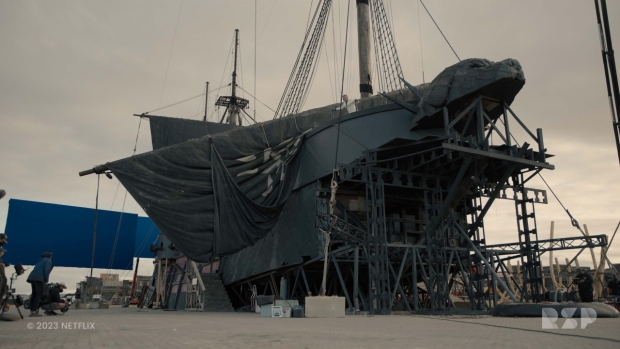The visual effects studio delivered 170+ shots for Netflix’s adventure series based on Eiichiro Oda’s popular manga, creating an array of CG naval and pirate ships, adding water and wind to fill the sails and set extensions to seamlessly integrate with the live-action.
Rising Sun Pictures (RSP) delivered more than 170 VFX shots for the first season of Netflix’s adventure series One Piece, which follows a young pirate, Monkey D. Luffy, and his ragtag crew on a quest for treasure and glory. The studio’s work centered on the array of naval and pirate ships featured in the show, a live-action adaptation of Eiichiro Oda’s popular manga. The series was developed for Netflix by Steven Maeda and Matt Owens.
RSP built a full CG version of the Going Merry, the ship piloted by Luffy and his Straw Hat Pirates. Artists used scans and photogrammetry of the on-set build as a base for the CG replica.
The live-action elements were shot in South Africa on a life-size, practical set designed to match Oda’s colorful artwork, including its iconic sheepshead bow. RSP’s artists enhanced the shot, adding detail to the deck, jib, masts, and sails using CG elements. Other subtle enhancements showed the effects of time and sea battles on the ship’s exterior.
The RSP team also built an entire CG version of the naval battleship commanded by Luffy’s principal antagonist, Marine Vice Admiral Garp, then combined full CG shots with live-action. An elaborate extension for a partial set included elements of the ship that conformed to its canine theme, such as masts shaped like bones and a crow’s nest in the form of a doghouse.
Artists over a dozen other full CG ships, including Cooking George, a large ship topped by a chef’s hat, and Orbit, with a brow shaped like a wine bottle.
“All of the ships are grounded in the manga, but we brought them into a live-action world,” said RSP VFX supervisor Dennis Jones. “It was fascinating to dig through artwork from the series’ 25-year history and soak up its unique aesthetic. Our aim was to assimilate its spirit into our work as much as possible. Our modelers had great fun with it. We loved the journey.”
The CG team brought a touch of realism to the vessels by studying technical drawings of caravels and galleons dating back to the 15th century and more modern cruise ships, sloops, and tankers.
“We asked ourselves, what features would each of these ships have if it was built in real life?” shared CG supervisor Naeem Chudawala. “Ships of the pirate era had large sails, tall masts, complicated rigging, and unique portholes. We were careful to apply ropes and chains in a way that conformed logically with their function.”
The RSP team integrated the ships into sailing sequences, setting them in motion and adding wind, water, and other environmental effects. Jones noted that his crew spent weeks developing a water simulation for the ocean that was used across multiple scenes.
“It had to work with different camera angles, perspectives, times of day and weather,” he explained. “Something that looks brilliant in a wide shot, might appear too big in a close-up. We experimented with different frequencies until we hit on one that worked consistently. We then used more traditional compositing techniques to create dynamic effects such as wakes and splashes as ships move through the water.”
Close collaboration between the studio’s CG and compositing departments was needed to place the ships into the water and get them to move naturally.
“We set up a system that allowed us to move ships at whatever speed we wanted,” explained compositing lead Boini Bharghava. “Ships interacted naturally with the FX ocean, generating wakes depending on their speed. For individual shots, production provided direction for the blocking and the look, and we took it from there. If a shot iteration needed adjustment, our system made that happen easily. From handling complex shots with good aesthetics to wide variety shots which involved matte paint extensions and seamless CG to live-action integration, our incredible compositing team really brought the shots to life.”
Throughout the VFX production, RSP collaborated with the series’ production team, Netflix, and Oda.
“The feedback was very positive,” recalled VFX producer Nigel Venning. “Oda commented on how happy he was with the development of the ships, and that was much appreciated by our artists, many of whom were longtime fans of the manga.”
CG ships appear in several extended sequences, including one at the center of the chase. Garp’s battleship pursues the Going Merry, shooting cannonballs at it. RSP’s VFX team created cannonballs, sparks, smoke, and impact debris. The team also added elements, including mist, sprays, swells, and thunderclouds, to a night scene showing the capsize of a tall-masted ship during a violent storm.
RSP’s most extensive task for the project was a 2,000-frame opener, beginning with the camera moving over a pirate map of the world before landing in the small harbor town of Loguetown. The narration comes from a long-dead pirate who describes the legend of One Piece, a treasure that holds the key to becoming King of the Pirates. RSP artists created many elements for the sequence, including the map, Loguetown, and over 20 ships filling the harbor.
“The title sequence establishes the world of One Piece,” explained Chudawala. “As we travel across the map, we visit important stops in the story, a swamped ship, sea creatures, etc. We’re letting the audience know what to expect.”
The studios’ work continued until just a few weeks before the show’s debut on Netflix.
“We were very proud of the way we were able to capture the spirit of the show and deliver rich, creative,” concluded Jones. “It was very rewarding to be given so much freedom and ownership over our shots. The results are really good.”
One Piece Season 1 is now streaming on Netflix.
Source: Rising Sun Pictures















